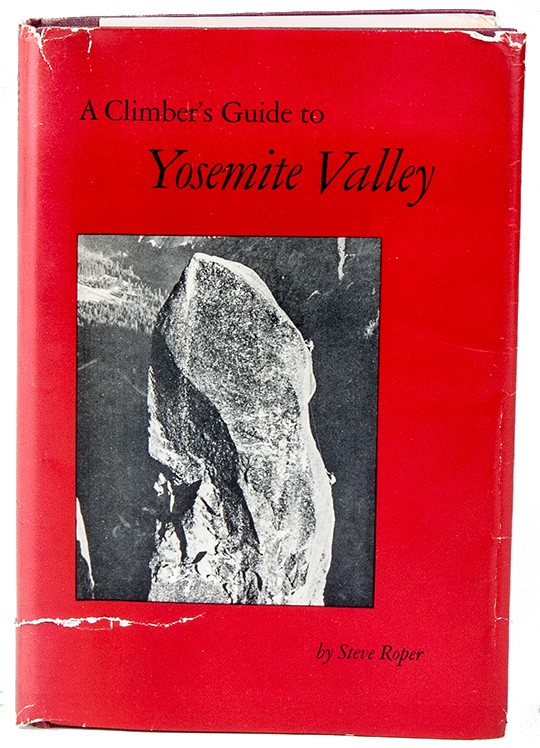Yosemite Valley, a mecca for climbers worldwide, boasts a rich history intertwined with groundbreaking ascents and a unique climbing culture. This guide delves into the heart of Yosemite, offering insights into its iconic routes, ethical considerations, and the essential knowledge needed to conquer its majestic walls. Whether you’re a seasoned veteran or a budding enthusiast, this climber’s guide will equip you with the expertise and understanding to navigate Yosemite’s vertical landscape.
In 1956, a young Steve Roper, just fifteen years old, embarked on his inaugural Yosemite climb. As route information circulated primarily through word of mouth, Roper’s burgeoning fascination with the Valley ultimately led him to author A Climber’s Guide to Yosemite Valley, the renowned “Red Guide” of 1964, a foundational text for generations of climbers.
 Steve Roper's Red Guide, a seminal text for Yosemite climbers, featuring a photo of Lost Arrow Spire on the cover.
Steve Roper's Red Guide, a seminal text for Yosemite climbers, featuring a photo of Lost Arrow Spire on the cover.
Groundbreaking Ascents and the Evolution of Climbing
The spring of 1960 witnessed Yvon Chouinard and Tom Frost pioneering the use of the Realized Ultimate Reality Piton (RURP), revolutionizing climbing possibilities within Yosemite’s intricate cracks. This innovation enabled ascents on previously unimaginable lines, such as Royal Arches Direct and the West Face of Sentinel, pushing the boundaries of what was achievable. Climbers like Roper gathered in Camp 4, sharing stories and beta around the campfire, fostering a vibrant and collaborative climbing community.
The Genesis of the “Red Guide”
While Chuck Pratt initially documented new routes, it was Steve Roper who meticulously compiled information, transforming scribbled notes into a comprehensive guide. The idea of a Valley-specific guidebook gained traction in Camp 4, and in 1963, Roper presented his vision to Dave Brower, the Sierra Club’s executive director. Despite initial concerns about overcrowding, the Sierra Club published Roper’s A Climber’s Guide to Yosemite Valley in 1964.
Inside the Red Guide: Routes, Ethics, and History
The “Red Guide” showcased 195 novel routes, each meticulously detailed with concise descriptions. Its impact extended beyond route information, as it also preserved the history of Yosemite climbing and fostered a developing code of ethics. Roper emphasized responsible climbing practices, highlighting the ethical dilemma of excessive bolting and its potential to compromise the challenge and integrity of a climb. The guide served as a crucial resource, providing climbers with essential information and promoting a culture of respect for the Valley’s natural environment.
The guide also contained striking black-and-white photographs showcasing climbers in action, alongside Al Macdonald’s detailed hand-drawn route topos.
Yosemite Decimal System: A Lasting Legacy
Roper’s book cemented the Yosemite Decimal System (YDS) as the standard for rating climbs. Before, there were multiple systems like the SC Mountaineering Committee’s Class 1-6 and the Decimal System developed by Royal Robbins, Don Wilson and Chuck Wilts, along with Leigh Ortenburger’s National Climbing Classification System (NCCS). Royal Robbins understood the importance of the choice and predicted that “whatever system you use…will become the national standard.”
Yosemite’s Transformation into a Global Climbing Destination
Upon returning to Yosemite in 1966, Roper witnessed the Valley’s burgeoning popularity among international climbers. As Yosemite transformed into a global destination, it was evident that the “Red Guide” played a pivotal role in attracting climbers to its legendary walls.
The Enduring Impact of the Red Guide
Joseph Taylor, in Pilgrims of the Vertical, aptly describes the 1964 edition as the “urtext of modern rock climbing.” The guide democratized access to information, empowering climbers and solidifying Camp 4’s reputation as a hub for climbing innovation. More than just a collection of routes, Roper’s A Climber’s Guide to Yosemite Valley became a symbol of the community’s shared passion and dedication to pushing the limits of climbing within this iconic landscape.
In conclusion, A Climber’s Guide to Yosemite Valley became more than a climbing guidebook; it became a cultural artifact that shaped Yosemite’s climbing community. It provided a foundation for future generations of climbers and instilled a sense of responsibility toward preserving the Valley’s natural beauty. As climbers continue to explore Yosemite’s granite walls, the “Red Guide” remains a testament to the enduring spirit of adventure and the importance of preserving climbing history and ethics.
